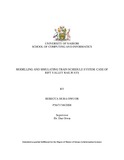| dc.contributor.author | Owuor, Rebecca H | |
| dc.date.accessioned | 2013-07-31T06:39:33Z | |
| dc.date.available | 2013-07-31T06:39:33Z | |
| dc.date.issued | 2013 | |
| dc.identifier.citation | Degree Of Master Of Science In Information Systems, University of Nairobi, 2013 | en |
| dc.identifier.uri | http://erepository.uonbi.ac.ke:8080/xmlui/handle/123456789/52788 | |
| dc.description.abstract | The use of ICT systems as a business enabler has introduced strong business competitiveness worldwide. Survival of businesses from small scale to high scale increasingly depends on implementation and usage of relevant business ICT systems to survive. Most firms that are still manual or semi-automated in carrying out their business processes have lost competence, relevance and no matter how strategic the business is with relevance to economic growth of a country, they have lost business leadership opportunities.
The main aim of this research was to develop and simulate a train scheduling system by implementing algorithms that use prioritization factors to achieve a schedule that reflects business -requirements and ensure safe train crossing. This was achieved by developing conceptual and system models based on requirements obtained from studying the existing processes and systems at Rift Valley Railways in Kenya. The developed system is capable of capturing the lengths of trains in a particular schedule, and gives priority to longer trains to pass while shorter ones wait at a station during crossing. The system also gives priority to passenger trains over cargo trains. Long distance passenger trains get top priority followed by commuter train and finally cargo trains. Cargo trains are prioritized in terms of nature of load, categorized as high, medium and low. If2 trains are of the same type and have the same priority, the system
uses First out first in option where the train given priority to pass is the one that arrived the crossing station first while the other waits.
The main conclusions from the research indicate that train scheduling can be done better at RVR through use of technology to achieve safety. Use of technology will also achieve better prioritization with reduced human intervention(decision in train operation. Another conclusion is that formality needs to be introduced in prioritization using heuristic algorithm that has set prioritization factors. Simplicity 'of system is a key success factor in places like RVR where use of technological tools is limited. Further work is recommended on this research and includes uploading scheduled track maintenance to the system to enable variable section time be taken into consideration by the algorithm. Real time schedule update as actual trains move to enable automatic schedule update with actual train dispatch and receipt as well as on Board train
computers to relay messages to train drivers from Control/stations was recommended by users. | en |
| dc.language.iso | en | en |
| dc.publisher | University of Nairobi | en |
| dc.title | Modelling And Simulating Train Schedule System: Case Of Rift Valley Railways | en |
| dc.type | Thesis | en |
| local.publisher | School Of Computing And Informatics | en |

